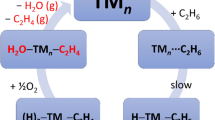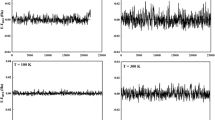Abstract
The activation of H2 molecules by Pt4 and Pt3V clusters was studied by the nudged elastic band (NEB) DFT/PBE0/def2tzvp quantum chemical method with construction of minimum energy paths (MEPs). In the case of Pt4 and Pt3V clusters, barrier-free dissociative adsorption of H2 molecules occurs at the platinum centers, while molecular adsorption of hydrogen occurs on the vanadium atom in Pt3V with a slight weakening of the H−H bond, but without its breaking. The specific features of coordination of H2 molecules are explained at the level of the MO method. Migration of the H atom from one cluster metal center to another in the model clusters (as probably in the case of hydrogen spillover) occurs at low activation barriers in the direction of the displacement vector corresponding to the normal vibrations of the system in the transition state. A significant role of Pt−H−Pt and V−H−Pt bridging groups in hydrogen migration has been revealed: they facilitate the transition of H atoms from one metal center of the cluster to another.









Similar content being viewed by others
Notes
The catalyst based on Pt3V, whose synthesis is described in [10], is planned for use in the hydrogenation/dehydrogenation of toluene/methylcyclohexane.
REFERENCES
D’Souza, L. and Regalbuto, J.R., Stud. Surf. Sci. Catal., 2010, vol. 175, p. 715. https://doi.org/10.1016/S0167-2991(10)75143-0
Chotisuwan, S., Wittayakun, J., and Gates, B.C., Stud. Surf. Sci. Catal., 2006, vol. 159, p. 209. https://doi.org/10.1016/S0167-2991(06)81570-3
Llorca, J., Homs, N., Sales, J., and de la Piscina, P.R., Stud. Surf. Sci. Catal., 1998, vol. 119, p. 647. https://doi.org/10.1016/S0167-2991(98)80505-3
Smith, M.W. and Shekhawat, D., Catalytic partial oxidation, in Fuel Cells: Technologies for Fuel Processing, 2011, ch. 5, p. 73. https://doi.org/10.1016/B978-0-444-53563-4.10005-7
Deng, Q., Li, X., Gao, R., Jun Wang, J., Zeng, Z., Zou, J.-J., Deng, S., and Tsang, S.C., J. Am. Chem. Soc., 2021, vol. 143, no. 50, p. 21294. https://doi.org/10.1021/jacs.1c08259
Popov, A.A., Shubin, Yu.V., Bauman, Yu.I., Plyusnin, P.E., Mishakov, I.V., Sharafutdinov, M.R., Maksimovskiy, E.A., Korenev, S.V., and Vedyagin, A.A., Nanotechnology, 2020, vol. 31, no. 39, p. 495604. https://doi.org/10.1088/1361-6528/abb430
Melnikov, D., Stytsenko, V., Saveleva, E., Kotelev, M., Lyubimenko, V., Ivanov, E., Glotov, A., and Vinokurov, V., Catalists, 2020, vol. 10, no. 6, p. 624. https://doi.org/10.3390/catal10060624
Mitsudome, T., Miyagawa, K., Maeno, Z., Mizugaki, T., Jitsukawa, K., Yamasaki, J., Kitagawa, Y., and Kaneda, K., Angew. Chem., Int. Ed., 2017, vol. 56, p. 9381. https://doi.org/10.1002/ange.201704199
Li, K., An, H., Yan, P., Yang, C., Xiao, T., Wang, J., Zhou, S., ACS Omega, 2021, vol. 6, no. 8, p. 5846. https://doi.org/10.1021/acsomega.0c06268
Fesik, E.V., Buslaeva, T.M., and Arkhipushkin, I.A., Zh. Obshch. Khim., 2020, vol. 90, no. 11, p. 1780. https://doi.org/10.31857/S0044460X20110207
Rozanov, V.V. and Krylov, O.V., Usp. Khim., 1997, vol. 66, no. 2, p. 117. https://doi.org/10.1070/RC1997v066n02ABEH000308
Shen, H., Li H., Yang, Z., and Li, C., Green Energy Environ., 2022, vol. 7, no. 6, p. 1161. https://doi.org/10.1016/j.gee.2022.01.013
Dadayan, A.K., Borisov, Yu.A., Zolotarev, Yu.A., and Myasoedov, N.F., Zh. Fiz. Khim., 2021, vol. 95, no. 5, p. 743. https://doi.org/10.31857/S0044453721050095
Xiong, M., Gao, Z., and Qin, Y., ACS Catal., 2021, vol. x11, no. 5, p. 3159. https://doi.org/10.1021/acscatal.0c05567
Sihag, A., Xie, Z.-L., Thang, H.V., Kuo, C.-L., Tseng, F.-G., Dyer, M.S., and Chen, H.Y., J. Phys. Chem. C, 2019, vol. 123, no. 42, p. 25618. https://doi.org/10.1021/acs.jpcc.9b04419
Chompoonut, R., Kajornsak, F., Noriaki, S., Nawee, K., and Supawadee, N., Int. J. Hydrogen Energy, 2018, vol. 43, no. 52, p. 23336. https://doi.org/10.1016/j.ijhydene.2018.10.211
Subramani, M., Arumugam, D., and Ramasamy, S., Int. J. Hydrogen Energy, 2023, vol. 48, no. 10, p. 4016. https://doi.org/10.1016/j.ijhydene.2022.10.220
Guo, J.-H., Li, X.-D., Cheng, X.-Lu., Liu, H.-Y., Li, S.-J., and Chen, G., Int. J. Hydrogen Energy, 2018, vol. 43, no. 41, p. 19121. https://doi.org/10.1016/j.ijhydene.2018.08.143
Kostyukovich, A., Gordeev, E., and Ananikov, V., Mendeleev Commun., 2022, vol. 32, p. 571. https://doi.org/10.1016/j.mencom.2022.09.001
Damte, J.Y., Zhu, Z.-J., Lin, P.-J., Yeh, C.-H., and Jiang, J.-C., J. Comput. Chem., 2019, vol. 41, no. 3, p. 194. https://doi.org/10.1002/jcc.26088
Du, J., Sun, X., Chen, J., and Jiang, G., J. Phys. Chem. A, 2010, vol. 114, no. 49, p. 12825. https://doi.org/10.1021/jp107366z
Zhang, X., Xu, C., Zhang, Y., Cheng, C., Yang, Z., and Hermansson, K., Int. J. Hydrogen Energy, 2021, vol. 46, no. 12, p. 8477. https://doi.org/10.1016/j.ijhydene.2020.11.278
Zavelev, D.E., Zhidomirov, G.M., and Tsodi-kov, M.V., Kinet. Catal., 2020, vol. 61, no. 1, p. 5. https://doi.org/10.31857/S0453881120010153
Matsura, V.A., Panina, N.S., Potekhin, V.V., Ukraintsev, V.B., Khokhryakov, K.A., Platonov, V.A., Tatsenko, O.M., and Panin, A.I., Russ. J. Gen. Chem., 2004, vol. 74, p. 975. https://doi.org/10.1023/B:RUGC.0000045849.54881.4f
Zavelev, D.E., Zhidomirov, G.M., and Tsodikov, M.V., Kinet. Katal., 2018, vol. 59, no. 4, p. 404. https://doi.org/10.1134/S0453881118040160
Henkelman, G. and Jonsson, H.J., Chem. Phys., 2000, vol. 113, no. 22, p. 9901. https://doi.org/10.1063/1.1329672
Asgeirsson, V., Birgisson, B.O., Bjornsson, R., Becker, U., Neese, F., Riplinger, C., and Jonsson, H., J. Chem. Theory Comput., 2021, vol. 17, no. 8, p. 4929. https://doi.org/10.1021/acs.jctc.1c00462
Neese, F., Wiley Interdiscip. Rev.: Comput. Mol. Sci., 2012, vol. 2, no. 1, p. 73. https://doi.org/10.1002/wcms.81
Neese, F., Wennmohs, F., Becker, U., and Riplinger, C., J. Chem. Phys., 2020, vol. 152, no. 22, p. 224108. https://doi.org/10.1063/5.0004608
Neese, F. and Wennmohs, F., ORCA Manual, Version 5.0.1, Mülheim a. d. Ruhr, Germany: Max-Planck-Institut für Kohlenforschung, 2021, p. 775.
Neese, F., Wiley Interdiscip. Rev.: Comput. Mol. Sci., 2022, vol. 12, no. 5, p. e1606. https://doi.org/10.1002/wcms.1606
Adamo, C. and Barone, V., J. Chem. Phys., 1999, vol. 110, no. 13, p. 6158. https://doi.org/10.1063/1.478522
Weigend, F. and Ahlrichs, R., Phys. Chem. Chem. Phys., 2005, vol. 7, p. 3297. https://doi.org/10.1039/B508541a
Schlegel, H.B., J. Comput. Chem., 1982, vol. 3, no. 2, p. 214. https://doi.org/10.1002/jcc.540030212
Lu, T. and Chen, F., J. Comput. Chem., 2012, vol. 33, no. 5, p. 580. https://doi.org/10.1002/jcc.22885
www.chemcraftprog.com.
Corbel, G., Topic, M., Gibaud, A., and Lang, C.I., J. Alloys Compd., 2011, vol. 509, p. 6532.
Waterstrat, R.M., Metallurgical and Materials Transactions B: Process Metallurgy and Materials Processing Science, 1973, vol. 4, p. 455.
Maldonado, A. and Schubert, K., Zeitschrift fuer Metallkunde, 1964, vol. 55, p. 619.
Mulliken, R.S., J. Chem. Phys., 1955, vol. 23, p. 1833. https://doi.org/10.1063/1.1740588
Hirshfeld, F., Theor. Chim. Acta, 1977, vol. 44. https://doi.org/10.1007/BF00549096
Luo, Y.R., Comprehensive Handbook of Chemical Bond Energies, Boca Raton, FL: CRC Press, 2007. https://doi.org/10.1201/9781420007282
Greenwood, N. and Earnshaw, A., Chemistry of the Elements, Amsterdam: Elsevier, 1984.
https://physics.nist.gov/asd. National Institute of Standards and Technology, Gaithersburg, MD. https://doi.org/10.18434/T4W30F
Pearson, R., Symmetry Rules for Chemical Reactions, New York: Wiley, 1976.
ACKNOWLEDGMENTS
This study was performed using computer resources provided by the High-Performance Computing Center of the St. Petersburg State Institute of Technology (Technical University).
Funding
This work was supported by ongoing institutional funding. No additional grants to carry out or direct this particular research were obtained.
Author information
Authors and Affiliations
Corresponding author
Ethics declarations
The authors of this work declare that they have no conflicts of interest.
Additional information
Translated by L. Smolina
Abbreviations and notation: DFT is the density functional theory; NEB, nudged elastic band method; МЕР, minimum energy path; МО, molecular orbital; АО, atomic orbital; TS, transition state; min, minimum; q, charge; Еtotal, total electron energy; ZPE, zero point energy; au, atomic units of energy; HSPE, hydrogen spillover effect.
Rights and permissions
About this article
Cite this article
Panina, N.S., Buslaeva, T.M. & Fischer, A.I. Activation of H2 Molecules on Platinum and Platinum–Vanadium Clusters: DFT Quantum Chemical Modeling. Kinet Catal 64, 588–602 (2023). https://doi.org/10.1134/S0023158423050075
Received:
Revised:
Accepted:
Published:
Issue Date:
DOI: https://doi.org/10.1134/S0023158423050075




